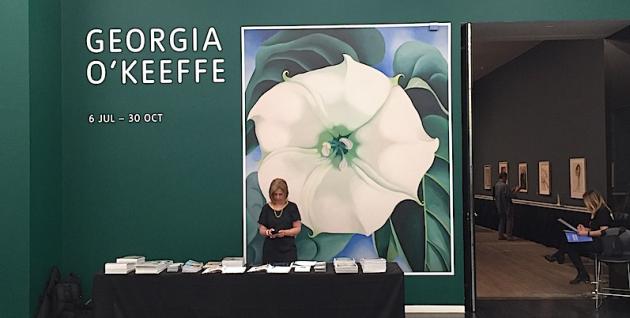Georgia O’Keeffe, now the subject of a large solo show just opened at Tate Modern, is a slightly odd case in the story of American art. She became famous very early, thanks to the efforts of her patron, lover and eventual husband Alfred Stieglitz, who, in addition to being a leading Modern Movement photographer, was a very active promoter of cutting edge Modernism in the United States. Having been a leading figure in the New York art world, she eventually withdrew from that to become the central presence in a new kind of regionalism, focused not on activity in the Mid West, but in New Mexico, and in particular on the art scene that grew up in and around Santa Fe.
There is a museum dedicated to her work in downtown Santa Fe, plus a separate research centre, and visitors can also make tours to her house and studio in nearby Abiquiu. No American woman artist enjoys such a degree of either posthumous or present popular celebrity. In fact, it may even be possible to say ‘no American artist whatsoever’ – not even such supposedly legendary figures as Jackson Pollock and Andy Warhol.
The acclaim given to her work was by no means always unanimous. In 1946, Clement Greenberg, at that time the self-appointed prophet of newly triumphant Abstract Expressionism, published an article in The Nation violently attacking an exhibition of O’Keeffe’s work that had just opened at the Museum of Modern Art in New York:
‘The importance of Georgia O’Keeffe’s pseudo-modern art [he wrote] is almost entirely historical and symptomatic. The errors it exhibits are significant because of the time and place and context in which they were made. Otherwise her art has very little inherent value.’ To Tate Modern’s credit, this assault in reproduced in the catalogue for their exhibition.
The catalogue is also careful to point out that the sexualised Freudian interpretations of her work, pioneered by Stieglitz, and the equally sexualised versions later on put forward by leading American feminists in the 1970s and 1980s, were specifically rejected by O’Keeffe herself. It is amusing to compare the abstract composition Grey Lines with Black Blue and Yellow, which dates from c, 1923, included in the Tate show, with Judy Chicago’s paraphrase of it in the place-setting dedicated to O’Keeffe in her installation The Dinner Party. There the forms O’Keeffe used are re-interpreted as a dinner plate that morphs into a vagina. The borrowing is obvious. So too is the spin Chicago puts on it. O’Keeffe, however, would have none of it, and rejected this interpretation in so many words. To today’s spectator – e.g. myself – the painting in question now seems like a prime example of something not entirely uncommon in the art of all epochs, of a truth being unconsciously told.
360˙Panorama Use Mouse To Navigate The Exhibition
Looking at the exhibition as a whole it offers a fascinating and not entirely expected narrative. O’Keeffe began as an abstract artist, who gradually transformed herself – in an exact reversal of the process one witnesses in the career of, say, Kandinsky – into a figurative one. Her abstraction seems to have had some roots at least in transcendentalist beliefs, of the kind that inform of the work of Hilma af Klint, another pioneering female abstractionist whose work has been recently exhibited in London. Belief systems of this type tend to embarrass commentators on early Modern Movement art – on the whole they prefer not to talk about them.
O’Keeffe’s progress towards figuration was fed, not by her interest in other painters – predecessors or members of her own peer group – but by her close contact with Stieglitz and other leading members of the Photo-Secession group of experimental photographers that Stieglitz funded. Particularly, perhaps by knowledge of the work of Paul Strand, who is hardly mentioned in the Tate catalogue. The Secessionists, for example, were radical exponents of the idea that a small part, an apparently insignificant detail, could be made to resonate more powerfully than the whole from which the photographer (or in her case the artist) has extracted it.
Her links to photography make O’Keeffe into a very obvious predecessor of Pop Art, though her subject matter is not the demotic urban imagery associated with Pop. O’Keeffe’s paintings of Kachina dolls, made in the 1930s, do, however, offer obvious, if unexpected, parallels with Pop. Coca-cola bottles, anyone? The comparison is reinforced by the fact that while O’Keeffe’s imagery is often very freewheeling – her roiling images of clouds, for example – her brushwork is not. For her the application of paint to canvas was not a pleasure it itself. It was a means to an end.
In fact the points where the exhibition falls down – which it does from time to time, but not very often – are when the images of New Mexico landscape, from the second half of her career, seem too picture-postcard-y and literal. Yet I think her roots in photographic ways seeing and thinking have played a big role in cementing her widespread popular reputation. Her work is immediately accessible to the demotic popular gaze in a way denied to many other big names in 20th century art. Greenberg’s comments spell out how this came to be resented.
Something else that links her to the world of right now is the way she was created and self-created as a celebrity. This process was begun in the long, obsessive series of photographs, often just details of her body, that Stieglitz made of her. Later, post Stieglitz, she came to resent and resist this process of canonisation, but she couldn’t entirely check it. She became, in the most literal sense, an American icon. This, essentially, is why there is a Georgia O’Keeffe museum flourishing now in Santa Fe. Yet no named Jackson Pollock Museum anywhere in America. You go there to visit a shrine, not just to see pictures.
Artlyst Vine Slideshow

